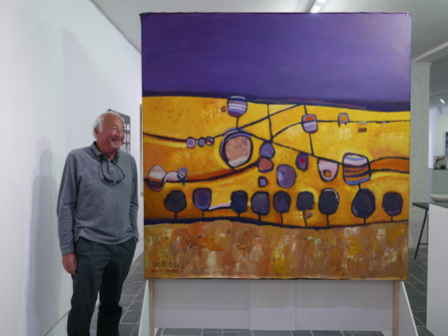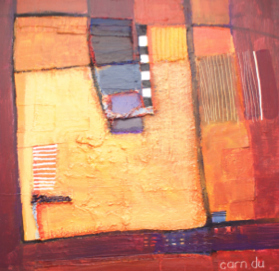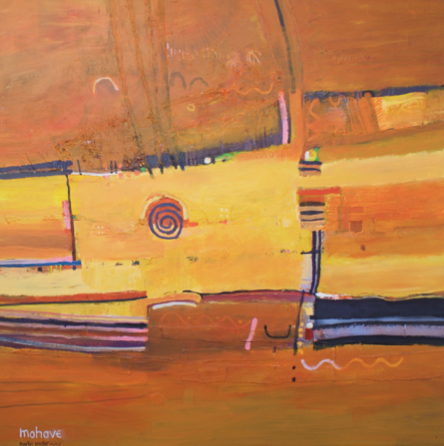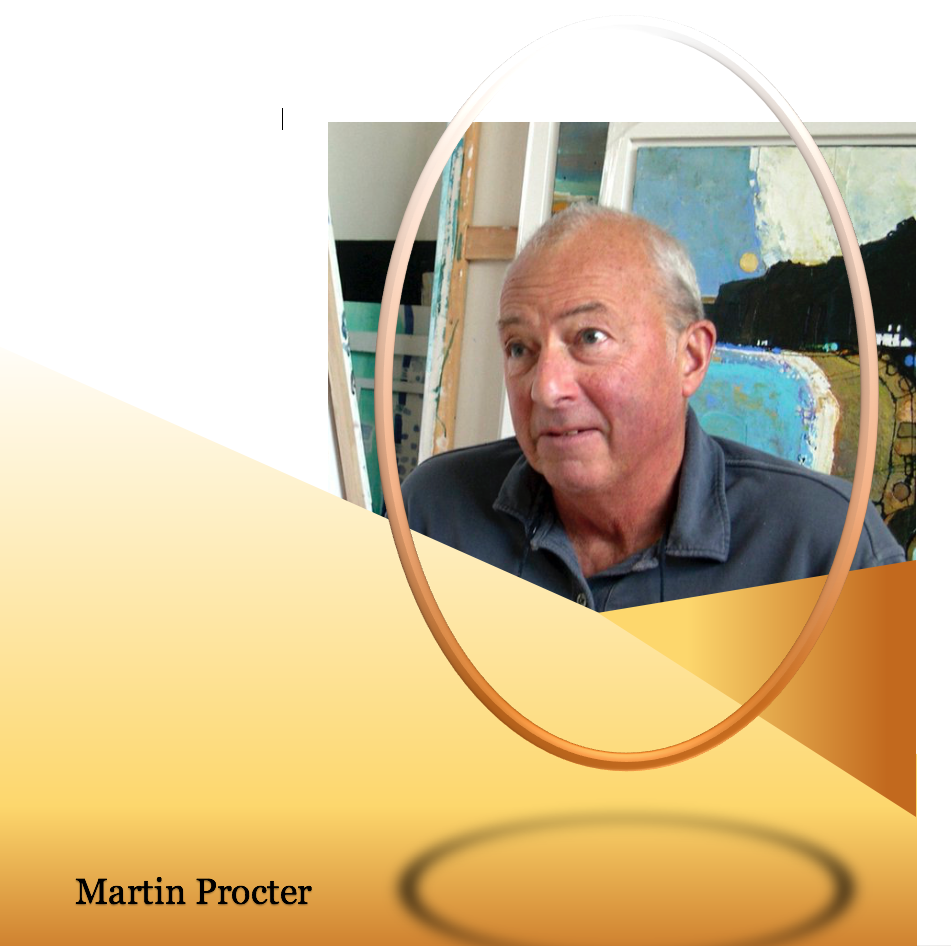The journey to my Solo Exhibition in St. lves, the world-renowned center for Contemporary Modern Art.
It is a gentle paradox that, while a picture may be worth a thousand words, for me a single word or two can be worth a new painting. Words, heard or read, sometimes found within a song or a poem, sometimes carefully considered, sometimes no more than a throwaway remark, are so often my starting point.

Around my studio lurk phrases on bits of paper, scribbled lines on the walls, a springboard for visual inspiration, waiting to be translated into abstract images. I see the work I now do as the art of omission, looking to reduce a subject to the minimum that still has resonance and honesty.
The image above is titled “Black Trees”; this came from hearing the Nashville singer Kim Richey’s song about traveling and displacement – “don’t know where we’ll sleep tonight, someplace far from here…” – an evocation of a journey through a strange landscape.
For me, since I was last in Carmel in 2012, with Tamara in her gallery, my artistic journey has held similar uncertainties about where my work was heading. I had just completed a series of paintings around the subject of migration; a big subject, full of different strands, the movement of animals and people, voluntarily and enforced, culture, music, money, disease. The series was exhibited with the British National Trust, and subsequently some of the paintings are now with collectors in the United States.

Then followed a period when we moved house, travelled – including a wonderful journey into the Atacama Desert – and I had an extended sabbatical from painting.
By the time I was ready to paint again, and for me that is an all-consuming commitment, I had lost three very good friends, all artists, kindred spirits, musicians, lovers of wild places.
I tried to get fired up by my familiar surroundings, here on Dartmoor in South West England, but failed to find motivation there, and instead painted a series of pieces about friendship, sharing good times, loss and reflection – not morose, more a celebration of what we had.

This set of paintings culminated in an exhibition with the Marine House Gallery in UK, and that marked the time for me to move on again. I decided to put myself in an unknown place for a few weeks, alone, with the thought of trying to paint how it felt to be there, rather than what the landscape looked like. Leaving my wife Viv at home, I travelled north to the Shetlands, wild and remote islands between Scotland and Norway, early in 2017, and rented a cottage for six weeks. I found all I was looking for – wild weather, big seas crashing on black cliffs, and long solitary walks in remote hill country. The paintings that resulted seem to confirm that the landscape won – they are much more about the physical reality of the place, rather than about my philosophical wanderings and confusions.
“…original thinking – if you’re not confused, you’re not thinking clearly.”
Tom Peters

I returned from the Shetlands feeling that I had re-found myself as in essence a landscape painter, in that the landscape in its widest sense would always inform my work, and I found a new freedom to make more powerful, intuitive paintings. I have always been fascinated by the underlying scale and geology of the natural world, in which man’s marks form a simple overlay, and this still is reflected in my new work. Jenny Pery wrote about me… “many of his paintings trace the enigmatic marks left by vanished people. He is fascinated by ancient markings on rock, shaman carvings on stones…he works on his canvases as if they were windows through which he can look into the past.”
THE PENWITH SOCIETY AND THE PENWITH GALLERY ST. IVES
Soon after my return from the Shetands I was given the wonderful opportunity to hold a solo exhibition at the Penwith Gallery in St. Ives – a very special privilege for any artist.
The Penwith Society was founded in 1949 by Barbara Hepworth, Ben Nicholson, Peter Lanyon, Sven Berin, Bernard Leach and Wilhelmina Barns-Graham, amongst others. This association with so many progressive and influential world-renowned artists has given the Penwith Society, and St. Ives, a unique place in British art history.
A charitable company – the Penwith Galleries Limited – was created to arrange a programme of exhibitions and manage the gallery complex, with three public galleries, artist studios, a print workshop, sculpture courtyard, and archive.
STILL PICKING BONES
This was a thrilling turn of events for me, which I embraced with full commitment. Fired up by my time in Shetland, I set out to put together a portfolio of the very best work I could do. I avoided my normal practice of a core theme, but gradually it became clear that the new work was becoming a reflection on my long connection with the landscapes I love – the tin mining coast of west Cornwall, my life here on Dartmoor, my hillwalking and climbing days in Wales, the Shetlands, and the wonderful contrasts I have found in Arizona and the Atacama deserts. My very first solo exhibition was titled ‘Picking Bones’- and I’m still out there picking bones! I invited the brilliant ceramicist Laurel Keeley to show her work alongside my thirty-six paintings, as I knew our work would fit together quite beautifully.

The exhibition looked terrific and was very well received. I spent most of my time down around St. lves enjoying being a part of that very special artistic community.
Now it is the time for me to once more take stock, reflect on what has been done, on where next I want to head, and wait for the creative juices to flow again. The last few years have been another big part of my journey as an artist; I have loved putting together this exhibition, I know I have given it my best shot, and I know that I’m a lucky guy to have all this in my life. As for what’s next, maybe it could be my time to head back to desert country …. the colors, the distant miles … simplifying, minimizing …. the art of omission.

